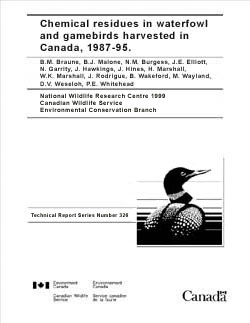|
|
 |
Publications
Technical Report no. 326
Chemical residues in waterfowl and gamebirds harvested in Canada, 1987-95
|

|
|
Braune, B.M., B.J. Malone, N.M. Burgess, J.E. Elliot, N. Garrity, J. Hawkings, J. Hines, H. Marshall, W.K. Marshall, J. Rodrigue, B. Wakeford, M. Wayland, D.V. Weseloh, and P.E. Whitehead, Chemical residues in waterfowl and gamebirds harvested in Canada, 1987-95, 1999
Abstract
HTML Version
PDF Version (2 Mb)
Hard Copy Not Available
.pdf (portable document format) - Download Acrobat Reader
|
|
Abstract
This report reviews data on chemical residues in Canadian waterfowl and gamebirds collected from across the country between 1987 and 1995 in order to: (i) obtain recent data on contaminants in gamebirds so that Health Canada could assess the risk to human health from eating those birds, and (ii) identify any potential avian health concerns related to the contaminant residue levels. Over 800 pools of waterfowl, gamebird and seabird muscle, egg and liver tissues were analysed for chlorobenzenes, chlordanes, hexachlorocyclohexanes, DDTs, mirex, dieldrin, octachlorostyrene, PCBs, arsenic, selenium, mercury, lead and cadmium. Selected subsets of samples were also analysed for polychlorinated dibenzo-p-dioxins (PCDDs), dibenzofurans (PCDFs), toxaphene or for 137Cs activity. These contaminants were either not detected or were found at very low levels in the majority of samples. The highest levels of most of the contaminants measured were found in those birds feeding at the higher trophic levels such as mergansers, loons and gulls. ÓDDT and ÓPCB were the compounds most frequently found above trace levels in pectoral muscle followed by ÓCBz and ÓCHL. ÓHCH and OCS were detected the least often. The highest DDE, ÓPCB and ÓCHL levels found were 2.5 mg·kg -1, 2.4 mg·kg -1 and 0.17 mg·kg -1 wet weight respectively. Mercury and selenium were found in the majority of samples at generally low levels. In only a few cases did contaminant levels approach or exceed levels associated with potential avian health effects or potential concern for human or animal consumers of the birds.
|
| |
|
Other CWS Publications
|
|